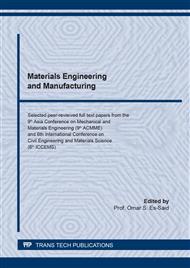p.15
p.20
p.25
p.31
p.41
p.50
p.57
p.62
p.68
Micro Electrical Discharge Machining Thermal Effect on Micro-Cracks Generation on Silicon Material
Abstract:
Various novel 3D micro machining technologies were researched and developed for silicon micro mechanical system fabrication. Micro EDM is one of them. The material removal mechanism is thermal sparking erosion and is completely independent with regards to the crystalline orientation of silicon, therefore there is no orientation constraint in processing the complex 3D geometry of silicon wafers. As thermal sparking implied, the process features local area high temperature melting and evaporating, and this characteristic has an adverse side-effect on the sparked surface integrity. One important concern is the generation of micro cracks, which would provide an adverse effect on the fatigue life of the micro feature element made of silicon. For this consideration, in this paper, with the experiment and SEM picture analysis approach, the author explored the micro crack generation characteristics on mono crystalline silicon wafers under micro EDM with available sparking energies and on the different crystal orientation surface machining. The generation of micro cracking is not only related with the sparking energy but also related with the crystalline orientation. The {100} orientation is the strongest surface to resist crack generation. For a strong-doped P type silicon wafer, there exists a maximum crack energy threshold. If single sparking energy is over this threshold, micro cracks unavoidably would be generated on any orientation surface. Two types of chemical etching post processes that can remove cracks on sparked surfaces are also tested and discussed.
Info:
Periodical:
Pages:
41-49
Citation:
Online since:
October 2021
Authors:
Price:
Сopyright:
© 2021 Trans Tech Publications Ltd. All Rights Reserved
Share:
Citation:


